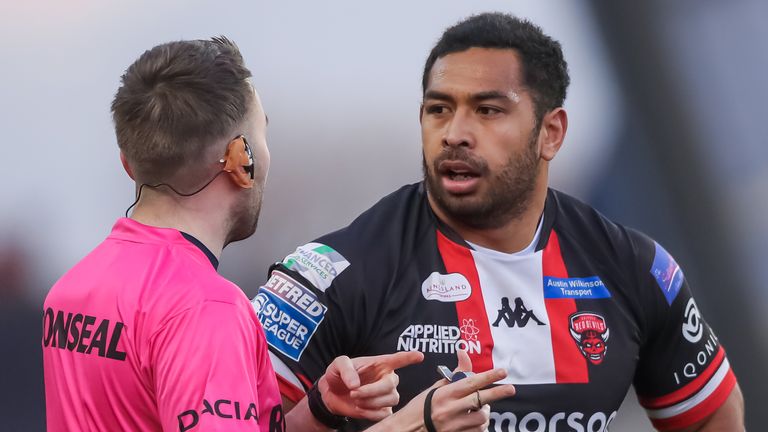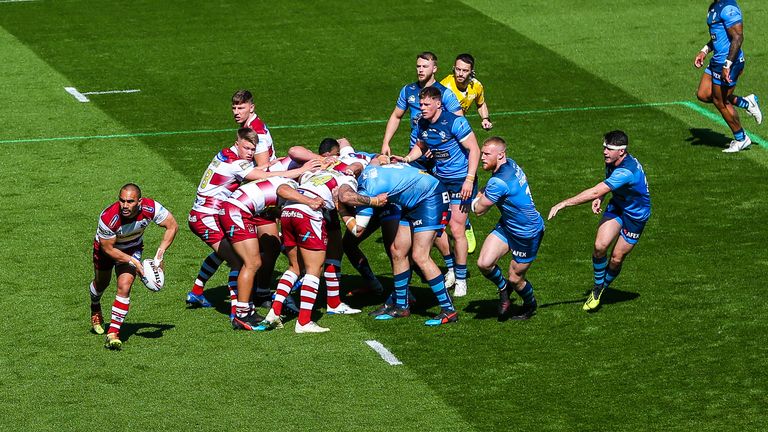Phil Clarke: Why rules of rugby league should be kept simple after changes cause confusion
Sky Sports rugby league expert and former Great Britain international Clarke looks at some recent rule changes and wonders if rugby league really is still a simple game
Friday 7 May 2021 18:35, UK
After watching a recent Super League match, Sky Sports rugby league pundit Phil Clarke asks whether recent changes to the Laws of the Game are making the sport unnecessarily complicated...
The great former Australia Test star Laurie Daley is often quoted as saying: "Rugby league is a simple game played by simple people."
I'll leave you to look up the rest of the quotation for yourselves as I want to examine whether that first statement is still true and if it is, what we want for the future.
Some of human history's greatest thinkers have been its strongest advocates of simplicity. Leonardo da Vinci said "simplicity is the ultimate sophistication", and a US military phrase coined by Kelly Johnson that gained worldwide popularity and changed many business practices is "keep it simple, stupid".
These examples perhaps justify the desire for simplicity as a means to improving rugby league, which has always evolved to survive. By paying its top players from its birth, it has forever needed to attract more money from crowds, sponsors, and now broadcasters.
Changes from the original rugby union rules, the play-the-ball instead of a scrum at every tackle, and reducing teams to 13 players to promote open play were simplifications that proved popular, differentiated the code as unique, and embedded it in our sporting culture.
Yet while our game's current influencers no doubt still seek improvement and the financial security of the sport, they no longer seem to value simplicity. Instead, they speak with almost one voice in their mantra to "speed up the game".
No mention came in last week's announcements confirming the harmonisation of rules ahead of this year's Rugby League World Cup of any desire to simplify nor even to protect the level of simplicity Daley previously described.
Their drive for speed in recent seasons has led us to have shot clock penalties which apply after different periods for goal-line drop-outs and scrums - when the latter return - and timekeepers to advise referees to stop the clock when goal kickers take longer than allocated.
Then there is a five-second period - 10, if the ball goes in touch - for one of two nominated players in each team to make choices over the positioning of lateral handovers following handling errors as opposed to fixed handovers if such an error happens on the last tackle of a set of six. This is on top of all the existing complexities in our rule book.
For example, our former Sky Sports colleague Stevo tells a tale in his autobiography 'Looking Back' about an incident during the successful 1972 World Cup campaign when a Great Britain try-scorer was poleaxed by the Australian full-back after he had scored, resulting in the French referee deciding to award a penalty after the conversion but before Australia kicked off. Hence the eight-point try.
This is, of course, different from the penalty try - but good luck explaining the difference to many casual and even some diehard, lifelong followers of the game.
If you manage to convey that one, try to explain the logic that a bouncing ball gathered by an opponent with one foot over the touch line results in his possession, but if he straddles the dead-ball or touch-in-goal line, he has to surrender possession by dropping out from the goal line within, what was it, 30 seconds for a drop-out not the 25 seconds for a scrum? Or is it the other way around?
When I consider some scenarios in rugby league this season, I didn't know whether to laugh or cry at one specific incident in a recent Betfred Super League fixture which exemplified the confusing state of affairs.
Neither the elite players on the field, including a former Man of Steel, nor the full-time referee, seemed to have mastered the latest - and, in my opinion, unnecessarily complex - set of amendments introduced. We have accepted these over several years into common practice and, in many cases, in defiance of what the game's published laws state.
This was clearly a knock-on by Hull Kingston Rovers after they kicked on the last tackle, but the Warrington Wolves player who dropped on the ball was subsequently tackled within 10 metres of both his own goal line and the touch line.
Referee Scott Mikalauskas had a clear understanding of what had happened and confirmed to both teams that there had been a knock-on on the last tackle, but as Warrington gained no advantage, there would be a hand-over.
He then looked at the Warrington players and asked, seemingly nobody in particular: "Where would you like it?" to which the answer was what almost every team has opted for on almost every occasion I can recall when awarded a, new-this-season, lateral handover: "In the middle", as opposed to on the 10 or 20 mark.
It is important to consider how we got here. Back in the mists of time, when scrums were a much bigger factor, there were just touch lines, but nowadays there are now five dotted lines running almost the length of the pitch, parallel to them.
Initially, two dotted lines at 10 metres in field were added to prevent scrums being set too close to touch. A second-phase tap on the 10-metre mark later replaced the scrum as a restart following a kick to touch from a penalty and was retained even when the rules were further amended to say scrums could be no closer than 20 metres from touch.
The end of a six-tackle set was also changed from a scrum to a handover play-the-ball set "where the scrum would have been" - except it was not. The rules said scrums couldn't be closer than 20m from the touch line but referees, from amateur to international level, routinely awarded any handover closer to the touch line on the 10-metre dotted line. Go figure!
Anyway, back to our scenario. As the referee ran off towards the clearly marked centre of the Warrington 10-metre line, his touch judge called him back. Because it was a knock-on on the last tackle, not earlier in the set, the lateral handover rule does not apply - a last-tackle infringement is a fixed handover.
Effectively, this is what we had in previous years. Unfortunately, both Mr Mikalaukas and Warrington hooker Daryl Clark then went to the 20-metre dotted line. The referee signalled the handover on the mark, only to get a further prompt from the sideline that it should be on the 10-metre dotted line.
Except, as we already discussed, perhaps it should really be on the 20m dotted line "where the scrum would have been". Possibly embarrassed at being saved by his colleague, Mr Mikalauskas had the good grace to apologise to both teams and carried on.
Perhaps bemused and no doubt a little less keen to get things moving quickly, Clark just tossed the ball to Josh Charnley to execute the handover play-the-ball. The whole episode took up around 20 seconds, by which time we probably would have completed a scrum - certainly in an average Championship or League One match where players don't have sight of a stadium shot clock.
I apologise to Mr Mikalauskas for highlighting this incident and I am not ref-bashing, but it is not surprising that it happened - and I wager it will happen again.
Moreover, another variation of misunderstanding will occur when it will not be noticed and nor will too many fans feel that their enjoyment has been spoiled by any such error, because what on earth does it matter?
I cannot see evidence of tactical advantages being taken by any astute captain electing "on the 10" or "on the 20", so they all choose "in the middle". Neither for that matter, have we seen many - if any - attempts at the other new rule, the 20-40 kick. It makes me wonder why our rules have become so complicated for so little gain.
Unfortunately, we have no Leonardos or Kelly Johnsons to produce simplified, sensible and consistent Laws of the Game, but I hope we soon find leaders who can recognise the flaws, stop over-complicating, and start to make it easier for those of us born into the rugby league population to explain the joys of our game to the other sports fans that our game still claims it seeks to attract.
Remember: "Rugby league is a simple game played by simple people" - and that's why we love it.









